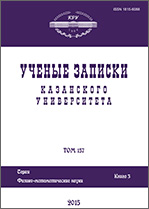|
|
Uchenye Zapiski Kazanskogo Universiteta. Seriya Fiziko-Matematicheskie Nauki, 2018, Volume 160, Book 4, Pages 603–616
(Mi uzku1481)
|
|
|
 |
Observation of daytime medium-scale traveling ionospheric disturbances using GNSS systems
R. O. Sherstyukov, A. D. Akchurin
Kazan Federal University, Kazan, 420008
Russia
Abstract:
The paper considers the problems of detecting midlatitude MSTIDs with a low intensity of disturbance $\Delta N/N$ using the method of transionospheric sounding with GNSS signals. For data collection, a dense network of GNSS receivers ( > 150) located in the territory of the Russian Federation has been used. On the basis of the obtained experimental data, we have shown the selectivity of the method of transionospheric sensing to the MSTID depending on the geometric conditions of observation. Thus, the use of two-dimensional maps of TEC variations has allowed us to simultaneously observe the signatures of the MSTID with the help of the R03 and G18 satellites (with similar geometric observation conditions). They have not been observed upon the usage of the R18 satellite. For a given spatial arrangement of the MSTID, the maximum amplitudes of TEC variations have been observed at elevation angles of the satellite-receiver lines-of-sight at about 50$^{\circ}$. The sharp drop in amplitudes has been observed at elevation angles more than 70$^{\circ}$. Using our GNSS data and representations of the spatial form obtained using incoherent scatter radars, a schematic model has been constructed to explain the reasons for the geometric conditions dependence of the GNSS method of transionospheric sounding. The proposed model has allowed us to obtain a method for determining the vertical slope of the MSTID using GNSS data. The technique implies observation of the dynamics of the amplitude of TEC variations depending on the geometric observation conditions.
Keywords:
ionosphere, MSTID, LSTID, perturbations of ionospheric plasma, F2 layer, TEC map, ionosonde, GPS/GLONASS.
Received: 27.06.2018
Citation:
R. O. Sherstyukov, A. D. Akchurin, “Observation of daytime medium-scale traveling ionospheric disturbances using GNSS systems”, Uchenye Zapiski Kazanskogo Universiteta. Seriya Fiziko-Matematicheskie Nauki, 160, no. 4, Kazan University, Kazan, 2018, 603–616
Linking options:
https://www.mathnet.ru/eng/uzku1481 https://www.mathnet.ru/eng/uzku/v160/i4/p603
|

| Statistics & downloads: |
| Abstract page: | 241 | | Full-text PDF : | 123 | | References: | 14 |
|




 Contact us:
Contact us: Terms of Use
Terms of Use
 Registration to the website
Registration to the website Logotypes
Logotypes







 Citation in format
Citation in format 